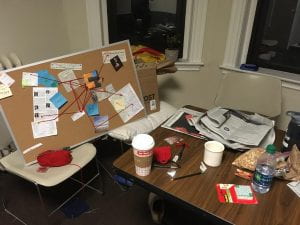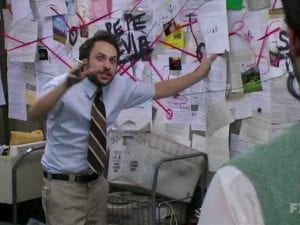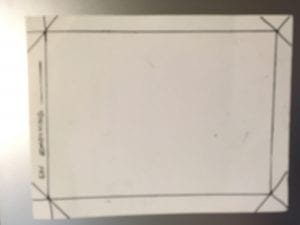Lingua Franca is a game for 4 players, in which three players have full access to a vocabulary of mechanics while one player starts the game with only the most basic vocabulary needed to play the game, and must build their vocabulary through trial and error.
THE RULES
At the beginning of the game, the four players must decide what roles each is going to take. A player who has played or watched the game before, must not play as the ‘foreigner’ (The one player initially not granted access to the full vocabulary). The three remaining players must decide which of the three following roles they want to play: The Passive, The Aggressive, and The Teacher.
The Passive player wins if by the end of the game, the Foreigner has successfully learned more terms from the blue vocabulary than red.
The Aggressive player wins if by the end of the game, the Foreigner has successfully learned more terms from the red vocabulary than blue.
The Teacher player wins if by the end of the game, the Foreigner has successfully learned the same amount of terms from both red and blue vocabularies. Additionally, the Teacher is allowed to teach the player two terms of choice at the beginning of the game.
At the start of the game, each player receives 2 Lingua points, and the the Teacher declares which two terms they wish to impart to the Foreigner. On their turn, players may spend 4 Lingua points to teach a term to the Foreigner. The Foreigner, however, may spend 3 Lingua points to learn a word at random (roll 1d10).
Once setup has been resolved, the game begins.
Gameplay takes place in rounds, wherein each player gets a chance to challenge another player to a die duel (the foreigner always goes last). During a die duel, each player must declare what type of die they will roll by reciting the appropriate word from the vocabulary. Then, the challenger must select UP or DOWN. Selecting UP determines that the player who rolls the highest number wins the duel, whereas selecting DOWN determines that the player who rolls the lowest number wins the duel. The winner of the duel gains a single Lingua point.
Once every player has gotten their chance to challenge another player to a duel, the game moves to the next round.
Throughout the game, players are allowed to utter words from their vocabulary to trigger their effects, changing the way the game plays slightly. The Foreigner may attempt to use one word per duel, and the Teacher must nod their head to confirm proper use of the term, or shake their head to confirm misuse of the term. If the teacher confirms proper use of the term, the Foreigner may spend 1 Lingua point to have the Teacher carry out the effects of the term, without explicitly telling the Foreigner what they are doing. No player is allowed to explain the vocabulary to the player by any means other than this, or spending Lingua points.
The game continues as such for a total of 3-4 Rounds. Once the game ends, players review what words the Foreigner has learned correctly, and declare a winner according to what the totals are.
REMINDER: PLAYERS ONLY GET ONE ACTION PER ROUND, OTHER THAN DECLARING THEIR DIE AND WIN CONDITION.
GREY VOCABULARY
| WORD | MEANING |
| Abboh (AH-bow) | “UP” – Declares highest roll wins duel. |
| Donnit (DOH-knit) | “DOWN” – Declares lowest roll wins duel. |
| Shooflee (SHOO-flee) | “6” – Declares player will use a six-sided die. |
| Shoofa (SHOO-fah) | “8” – Declares player will use an eight-sided die. |
| Shakhi (SHAH-kee) | “10” – Declares player will use a ten-sided die. |
| Grongo (GRON-go) | “Hello!” – A greeting. |
| Zupa (ZOO-pah) | “Goodbye.” – A farewell. |
| Tipi Tipi (TIH-pee TIH-pee) | “Thank you.” or “You’re welcome.” |
| Whoh (Whoa) | “Sorry!” or “Oops!” |
BLUE VOCABULARY
| WORD | MEANING | RANDOM LEARNING NUMBER |
| Plissi (PLEE-see) | “More” – Say this as a player rolls their die. Grants a player’s roll a +3 bonus. May not be used on self. | 1 |
| Sisaroom (Sis-ah-ROOM) | “Tie, Draw” – Offer this to your opponent. If the other player replies with “Sisaroom” as well, the duel is decided with a match of Rock Paper Scissors instead. | 2 |
| Germit (JUHR-mitt) | “Profit” – Offer this to your opponent. If the other player replies with “Germit” as well, the winner of the duel gains two points instead of one. | 3 |
| Bohppet (BOP-it) | “Lucky” – Offer this to another player other than your opponent. If the other player nods, you may roll with advantage (roll twice, take highest). Otherwise, this action is void. | 4 |
| Grumpipo (GRUM-pee-po) | “Tiny, Small” – Declares player will use a four-sided die. | 5 |
RED VOCABULARY
| WORD | MEANING | RANDOM LEARNING NUMBER |
| Bouppa (BOO-pah) | “Less” – Say this as a player rolls their die. Grants a player’s roll a -3 penalty. May not be used on self. | 6 |
| Pacaboo(PAH-kah-boo) | “Steal” – Offer this to your opponent. If the other player replies with “Pacaboo” as well, the winner of the duel steals 1 Lingua point from the loser. | 7 |
| Grimboh (GRIM-bow) | “Gamble” – Offer this to a player other than your opponent before you roll your die. If they nod in response, trade dice with your opponent. Otherwise, this action is void. | 8 |
| Twistett (TWIST-it) | “Unlucky” – Offer this to another player other than your opponent. If the other player shakes their head, you may roll with disadvantage (roll twice, take lowest). Otherwise, this action is void. | 9 |
| Galanga (gah-LUN-gah) | “Large, Giant” – Declares player will use a twelve-sided die. | 10 |

The tally of learned words by the end of the game.

The ‘Foreigner’, being taught a new word.

The ‘Foreigner’s sheet by the end of the game, full of notes and learned words.

Players in the middle of a round, checking their vocabularies.
ARTIST’S STATEMENT
The original intent of this game, was to represent a familiar experience of mine that can’t be that easily abstracted, or at least, not accurately. I set out to try and accomplish something that not a lot of games have done (as far as my knowledge), which was to condense the experience of learning a new language and adjusting to a new linguistic environment, into a set of concise mechanics. While the game ultimately became more complicated on the players than I intended, that managed to carry the meaning through more effectively.
Observing other games and movements we studied in this class really helped me with the ideas and direction as to how I would abstract this experience into a game that other people of background different from mine, could run through. The multi-cultural movement of Dada actually helped me quite a bit in this respect, because seeing all of these artists from different areas of the world like Zurich, Berlin, Paris, all come together and create works within the same movement helped me find similarities in the fact that none of those artworks in particular had a language barrier blocking their meaning.
Fluxus kits and movements also really helped me figure out a better structure for the game, considering that they helped me see a path towards better abstracting this experience into a simpler, briefer game. I saw fluxus kits and other works like those featured in Yoko Ono’s Grapefruit, I saw as being great examples of somewhat simple tasks that ultimately carry their own meaning to the “player”.
Not to mention the appropriation unit was integral to the idea of this game, because the basic idea of the game I saw as an appropriation of the card game “Mao”. In the game, no player is allowed to explain the rules to a newcomer, so the newcomer must figure them out through experience. This game did, in that mechanic, include a large amount of the meaning I wanted to convey , but not with the same context. The set of appropriation examples we saw during that unit, such as the projects we had to make (Settlers of Catan, Global Warming style in my example), influenced by altered games such as red chess, helped me find some sort of middle ground between using the same mechanic and being able to draw it into the context I wanted to.
The end result of those influences and my experiences became Lingua Franca, a game that I think does a pretty decent job of really condensing my personal experience with language barriers. Through observing, I could tell that the players were trying to learn but struggling a bit to take in the vocabulary, as I intended. They weren’t struggling on behalf of the meaning of the words, they seemed to struggle in piecing them together to the larger picture of the game and how their actions would translate to how the game changes. This was more of a byproduct of the mechanics, but a convenient one at that.








